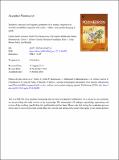Synthesis, structure and magnetic properties of an unusual oligonuclear iron(III)-cobalt(III) compound with oxido-, sulfato- and cyanido-bridging ligands
Abstract
The synthesis, characterization, structure and magnetic properties of a hexametallic mixed-metal iron(III)-cobalt(III) compound are described. The compound has been characterized by standard spectroscopic and analytical methods to determine its composition. Single-crystal X-ray diffraction has shown that the asymmetric unit consists of discrete dinuclear dicationic units of {(µ-oxido-µ-[sulfato–O1,O2])bis[tris(2-pyridyl-methyl)amineiron(III)]}2+, herein designated as Fe12, and two half-dinuclear dianionic units of {(µ-oxido)bis[iron(III)]}2– units, herein designated as Fe33a and Fe44b, generating the overall composition Co2Fe4O2(CN)12(tpa)4, 1 , where tpa is tris(2-pyridylmethyl)amine. X-ray structural results and thermogravimetric and differential scanning calorimetry measurements also indicate that the compound, depending upon its history may contain up to nine interstitial waters of hydration, herein designated as 1 (H2O)9. In the dinuclear dicationic unit, the bridging Fe–O–Fe bond in Fe12 is bent and there is also an Fe-O-S-O-Fe sulfato-based bridge with an angle of 132.8°. In contrast, in the two dinuclear dianionic units, Fe33a and Fe44b, the Fe–O–Fe bond angle is crystallographically constrained to be linear. The Co–CN–Fe bonds are almost co-linear, with Co–C–N angles of 176° and C–NFe angles of 169°–. In each species the tpa ligand is tripodal tetradentate with the tertiary amine trans to the sulfato ligand or to the cyanide ligand in the dianions or the bridged oxido ligand in the dications. Bond lengths and angles are all in the typical range for Fe(III) and Co(III) compounds. The magnetic behavior of 1 (H2O)9, obtained upon cooling from 300 to 2 K, reveals a strong antiferromagnetic interaction between the Fe(III) ions in each dinuclear unit. Attempts to discriminate between the two Fe(III) dinuclear units in 1 (H2O)9 have in all cases led to two very different Heisenberg isotropic exchange coupling constants, namely J= –220(2) and –716(32) cm–1 for 1 (H2O)9; i.e.. one of the dinuclear units, probably the Fe12 unit, is so strongly antiferromagnetically coupled that it is close to diamagnetic between 2 and ca. 250 K and has a Heisenberg S = 0 ground state.
Citation
Setifi , F , Setifi , Z , Konieczny , P , Glidewell , C , Benmansour , S , Gómez-García , C J , Grandjean , F , Long , G J , Pelka , R & Reedijk , J 2018 , ' Synthesis, structure and magnetic properties of an unusual oligonuclear iron(III)-cobalt(III) compound with oxido-, sulfato- and cyanido-bridging ligands ' , Polyhedron , vol. In press . https://doi.org/10.1016/j.poly.2018.10.021
Publication
Polyhedron
Status
Peer reviewed
ISSN
0277-5387Type
Journal article
Description
The authors are in debt to the Algerian DG-RSDT (Direction Générale de la Recherche Scientifique et du Développement Technologique) and Université Ferhat Abbas Sétif 1 for financial support. SZ thanks Dr Ewa Juszyńska-Gałązka, from the Institute of Nuclear Physics Polish Academy of Sciences, for performing FT-IR measurements using EXCALIBUR FTS-3000 spectrometer. The magnetic part was supported by the Generalitat Valenciana (PrometeoII/2014/076 project) and the Spanish MINECO (project CTQ2017-87201-P AEI/FEDER, UE).Collections
Items in the St Andrews Research Repository are protected by copyright, with all rights reserved, unless otherwise indicated.

